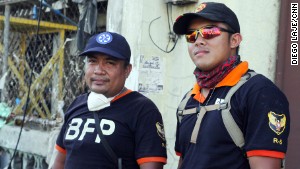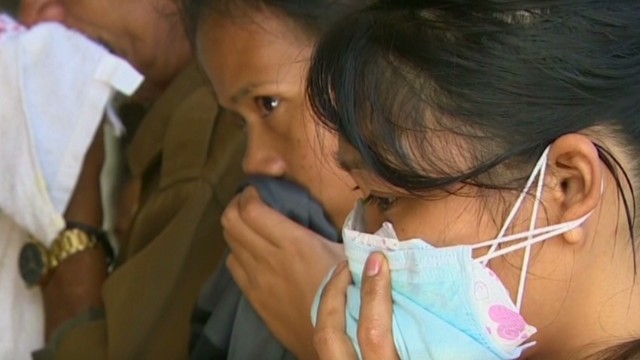Typhoon Haiyan: The grim task of recovering Tacloban's dead
November 18, 2013 -- Updated 0659 GMT (1459 HKT)
STORY HIGHLIGHTS
- These men go from one street to another gathering corpses
- Officials are still struggling to quantify the dead
- The hardest part are the long days, the men say
- They shrug off the mental toll
But their deeply unenviable task is a vital step toward getting Tacloban, the Philippines city decimated by the fury of Super Typhoon Haiyan, back on its feet.
They are the body collectors -- the men who go from one debris-laden street to another, gathering the corpses left by the devastating storm and ferrying them in trucks to the outdoor morgue or mass graves.
Amid the humid heat and the frequent rain, the work is grisly and arduous.
"It's very hard for us," says Don Pomposo, a fireman sent to help Tacloban from another region of the country with 15 of his colleagues. "It's too hard."

Pomposo, left, and Torena.
Quantifying the dead
The bodies that remained in the city's streets for days after the typhoon became a grim symbol of Haiyan's destructive power and the temporary breakdown in government operations that followed.
Officials are still struggling to quantify the dead. At the very least, hundreds of people were killed in Tacloban. Nationwide, the death toll from the typhoon stands at 3,976, authorities say, with another 1,598 missing.
Over the past few days, progress has been made in central areas of Tacloban in the gathering and clearing of bodies, whose putrid odor has people constantly covering their noses and mouths and worrying about the possible consequences for their health.
 Philippines survivors crowd airport
Philippines survivors crowd airport  CNN's Anderson Cooper defends coverage
CNN's Anderson Cooper defends coverage  Man makes contact with typhoon family
Man makes contact with typhoon family
Although those fears may be exaggerated, the continued presence of the bodies -- lined up on the streets in bags, or still buried in large areas of jumbled wreckage where houses once stood -- is a macabre reminder of how far the city still has to go to recover from its horrific ordeal.
Stomach-turning sights
Pomposo and his colleague Vincent Albert Garchitorena are among those working hard to help Tacloban move forward. Their team recovered 76 bodies from one street during a single morning this weekend, they say.
Clad in black T-shirts and pants tucked into tall rubber boots, they are stoical as they talk about the stomach-turning sights that confront them.
The main difficulty, they explain, is to keep going for the duration of the roughly 10-hour days they have to endure.
"We just need complete rest after working," Pomposo says, standing near a pile of stinking debris.
He has a face mask, and Garchitorena a scarf, to block out some of the stench. They both wear baseball caps to shield them from the scorching sun. But there is nothing that can protect their eyes from what they see.
The bodies they've collected over the past several days span the age range, from babies to the elderly. On occasion, they've come across dead pregnant women.
The corpses they were finding over the weekend have been festering for more than a week in the baking heat. In certain cases, decomposition is advancing rapidly.
Some of the bodies have lost their eyes, they say. Others are riddled with maggots.
The mental toll
The WHO warns that "anyone in charge of a body recovery team should be aware of the stress and trauma that team members might feel, and provide support for this where possible."
But Pomposo and Garchitorena shrug off concerns about the mental toll the experience may be having on them, even though they've never done this kind of work before.
They say they're not suffering from nightmares. They just want to get the job done and head back to Bicol, the region a few hundred kilometers northwest of Tacloban where they're from.
Their clothes retain the stench of death from one day to the next, and they have to wash themselves over twice to try to get rid of the smell from their skin.
But they show more concern for the stricken people of Tacloban than they do for themselves.
"They will have to start from zero," says Garchitorena, his eyes hidden behind a pair of reflective sunglasses.
A state of flux
The two firemen say the situation in the city has changed from the unruly conditions they witnessed when they arrived early last week, a time when law and order had broken down and looting was rife.
Now, Tacloban is in a state of flux. Many residents who survived the typhoon, especially women and children, have left to stay with relatives elsewhere until the situation improves. People from badly hit communities in the surrounding areas have also flowed through the city.
Like the firemen, large numbers of the government employees working to clear up Tacloban and provide aid to storm victims have come in from other parts of the Philippines. And ordinary people from other regions have also rushed there to look for missing relatives and help survivors.
Added to that is the influx of international aid workers and foreign journalists.
Edwin Manaus stands outside the Stephanie Smoke Haus restaurant in the center of town, known locally for its all-you-can-eat buffet. He tries to make sense of the upheaval.
The streets appear to have gotten busier over the weekend, as more debris was cleared and an improved gasoline supply allowed more people to use scooters, motorized rickshaws and a variety of other vehicles to move around and reach food distribution points.
But despite the increased bustle, Manaus says the city feels emptier to him, with so many of the regular residents gone, including many members of his family.
"I need people for my business," he says, gesturing toward the darkened interior.
Shocking devastation
He also needs electricity and running water before he can reopen. He says he heard a rumor that the power could be back on as soon as next week, but city officials said late last week that it could take months.
The businesses that do appear to be thriving in the early days of recovery are improvised market stalls in a northern part of the city, near the poor, severely damaged neighborhood of Paseo de Legazpi.
Some goods on sale, like fresh bananas, appear to have come in from neighboring provinces. But other products -- like umbrellas, cigarettes and coffee -- are most likely taken from the looted stores nearby, locals say.
The devastation in Paseo de Legazpi, where many people lived in flimsy shanties, remains shocking. The creek that runs through the neighborhood is full of the splintered remains of homes and their contents, along with the bloated carcasses of several very large pigs.
The body collectors are likely to have a grueling task ahead of them, gathering what still lies amid the area's tangled wreckage.
Pomposo and Garchitorena say they don't know how long they'll have to stay. But they've already planned what they'll do when they eventually get back to Bicol.
"Rest, sleep and drink a cold glass of water," says Garchitorena.
To which, Pomposo adds, "File for vacation leave."


ไม่มีความคิดเห็น:
แสดงความคิดเห็น